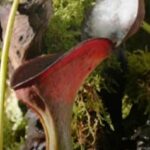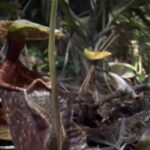As an Amazon Associate, this site earns commissions from qualifying purchases. For more details, click here.
Pitcher plants are known for a lot of things, but for most of us the biggest attraction is the way they trap and eat insects. They are known for preying on ants, gnats, beetles and spiders, but what about butterflies? Is it safe for a nepenthes or sarracenia to eat these insects, or are they best avoided?
Pitcher plants will eat a butterfly if it falls into their trap because it is a source of nutrition. However, only large pitcher plants can do this because butterflies can fly and escape the pitcher.
Why Do Pitcher Plants Eat Butterflies?
Pitcher plants eat butterflies for nutrition. Nepenthes and sarracenia only grow in poor soil which lacks nitrogen and other important elements. So these plants had to find other sources of nutrients to survive.
There are many pitcher plant species, but they all grow in the same poor ground. In fact these plants will die if you use rich, fertilized potting media. However, nepenthes still require nitrogen just like other plants. But instead of the soil the plants get them from insects.
So if you are going to cultivate or propagate pitcher plants, you have to use carnivorous plant soil. A good example of this is Doter Sphagnum Moss Potting Mix which is ideal not just for pitcher plants but Venus flytraps, butterworts and sundews.
Butterflies, moths and other insects have the nutrients these plants need. The plant extracts nutrients from the butterfly and puts it to work. Nitrogen, phosphorus and other elements speed up growth and development.
How Pitcher Plants Benefit From Eating Insects
The nutrients from a butterfly are not food. Pitcher plants use photosynthesis to create glucose, which is food for plants. These nutrients are like supplements which boost the immune system of plants. They serve as additional resources to create pitchers, produce nectar, the liquid in pitchers, make more leaves etc.
Pitcher plants consume eat bugs to meet their nutritional requirements. You can think of butterflies and other bugs as similar to the supplements we take. They are not essential for survival, but they do help a lot.
Can pitcher plants survive without eating butterflies? Yes, these plants will live without eating insects. Their growth will slow down, but the plants will live. If nepenthes and sarracenia do not eat, more sunlight, water, soil and humidity will be required.
But if you are growing pitcher plants it is better to feed them. They get a lot of benefits from these nutrients so feeding makes sense. And even if you are new to carnivorous plants, the feeding process is really simple.
How to Feed Butterflies to Pitcher Plants
Pitcher plants are easy to feed, which makes them ideal for beginners. Whether you are growing sarracenia or nepenthes, the process is similar.
First, only indoor pitcher plants have to be given food. Aside from the occasional housefly and mosquito, access to food is severely limited. This is especially true if the plant is in a terrarium. In these instances you have to feed them.
To feed butterflies to a pitcher plant, grab the insect and place it in the pitcher. Use tweezers like these from Eskoni to make things easier. Once you drop it into the pitcher, liquids will prevent the insect from escaping (assuming it is still alive). Nepenthes and sarracenia do not distinguish between live and dead bugs.
If your pitcher plants are outdoors, no feeding is necessary. Butterflies, moths and other insects will be lured to the trap. The pitchers on a pitcher plant are moistened by nectar and insects are drawn to this scent.
For more details you can check out this guide on feeding pitcher plants.
How Many Butterflies Can Pitcher Plants Eat?
Pitcher plants can be fed at least one insect a month. But you can increase this to 2-4 times a month during the growth phase from spring to early fall.
However some pitcher plants can handle more food. For instance some nepenthes are fed once a week or every two weeks. You can feed just one pitcher or 2-3 pitchers every two weeks or so.
If you are not sure, check the instructions that came with the plant when you bought it. You can also experiment and check how many bugs the plant can eat.
You can start by feeding it once a month, one pitcher only. If the plant eats the bug completely, increase feeding frequency to every two weeks.
Pitcher plants growing in an ideal environment will live for a long time. Under optimum conditions these plants will be fine with fewer nutrients. Many growers feed their sarracenia or nepenthes once a month and the plant is fine.
Most pitcher plants are fed every two weeks, but some can handle weekly feeding. This comes down to the pitcher plant and how much you are feeding it. If you have a large nepenthes but only feed it ants, weekly feeding will not hurt.
But if the plant eats large bugs, there is no need to give it too much food. If you put a lot of butterflies in its pitcher, they will just remain there and decompose. Pitcher plants will not consume more bugs that it requires.
If your hang your pitcher plants in the garden, feeding will not be an issue. Let the insects come to the plant and let it digest as many as it requires. This is one of the benefits of growing pitcher plants outside.
How Pitcher Plants Digest Butterflies
Pitcher plants secrete nectar, a sweet smelling substance that attracts butterflies, moths, spiders and other insects. This substance is spread all over its pitchers, in particular the rim and the inside walls.
A butterfly for example, will pick up the scent and gravitate towards the pitcher. In many instances, the insect drops down onto the rim and slips into the cavity. This happens because the nectar – and other liquids – make the pitcher surface and walls very slippery.
Any small insect that falls into the pitcher gets trapped. Inside are viscous liquids that cover the wings of the butterfly. The more it struggles the more it gets caught up in the substances. Finally, the creature dies from exhaustion or is chocked by the liquids.
At some point the pitcher plant will secrete digestive fluids to break down the butterfly tissues. If the liquids inside the pitcher do not kill the insect, these digestive enzymes will. These fluids are harmless to humans and pets but they can dissolve a small bug.
Once the insect is dissolved the plant absorbs all of it, along with its digestive juices. As it is being consumed, these are turned into nitrogen and other elements.
The digestive process can take a few hours or several days depending on the size of the meal. In some instances, there may be leftovers in its pitcher, the parts that its digestive juices could not dissolve.
Tips For Feeding Pitcher Plants
While feeding butterflies to pitcher plants is easy, there are still a few things you need to consider. Keep these in mind no matter what you are feeding it.
- Do not give the plant too much food. If your nepenthes looks healthy with a once a month feed rate, let it be. All those uneaten insects will rot and make the plant smell bad.
- Try different foods. Butterflies provide nutrients, but it will not hurt to give it mealworms, bloodworms or fish food.
- Soft food is best for pitcher plants. Mealworms are perfect examples of soft food. Beetles and cockroaches have hard shells that require more digestive juices. Pitcher plants can eat those, but it requires more resources.
- Pitcher plants take time to digest. Once you drop food into a pitcher, it might take days before the plant eats it. This is normal.
- Nepenthes are tropical plants and do not require dormancy. Their appetite should be the same all year round. Sarracenia go dormant in winter and they do not eat during this period.
Conclusion
When we think of pitcher plant food, flies, beetles, ladybugs and spiders come to mind. But in fact, nepenthes and sarracenia will eat butterflies if given the opportunity. So if you see a butterfly or two in their pitchers, it is nothing to worry about.

My fascination with carnivorous plants began many, many years ago with Venus Fly Traps. Now I am more than happy to impart what I know with other enthusiasts and those who are curious about meat eating plants.



